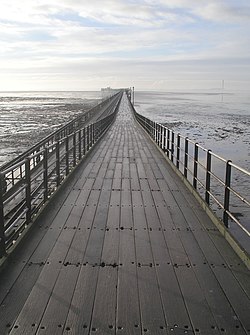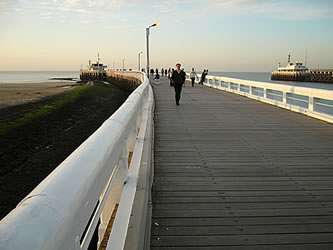 Clevedon Pier in Somerset
Clevedon Pier in SomersetThe piers are part of the English landscape since the Victorian era. There are 55 surviving piers in the UK today out of the hundred which were built since the 19th century. Their first function was to allow ferries and boats to berth in deep waters without getting closer to the coast. The first pier ever built in Great Britain was Ryde Pier, built in 1814 on the Isle of Wight.
 Ryde Pier
Ryde PierLater in the 19th century, piers also turned into leisure places. This period was indeed the beginning of a new touristic wave to the English seaside thanks to the recent introduction of railways. The piers were mainly built to allow tourists to walk along the seaside. Southend Pier was built in 1830 to that touristic end. It is by the way the longest pier ever built in the UK (7,080 feet, which corresponds to 2,158 metres).
 Southend Pier
Southend PierPiers are a real cultural icon of the UK since some of them became really famous. One of these is Brighton Pier. Brighton Pier is a pleasure pier also known as Palace Pier. It was opened in May 1899. Nowadays, you can find a casino, roller coasters and even a log flume on the pier.
 Brighton Pier
Brighton PierThe piers were such a great success in the UK that they were exported overseas. One of the most famous piers in the US is the Ocean Beach Pier in California which is the longest pier of the West coast of the US (1,971 feet or 601 metres).
 Ocean Beach Pier
Ocean Beach PierThere are even 3 piers in our beloved country. You can see them in Blankenberge, Oostende and Nieuwport.
 Oostende Pier
Oostende PierUnfortunately some of the piers had to be destroyed or did not survive over the years. This is why the National Piers Society is currently promoting the preservation of these cultural icons, witnesses of the Victorian era.
Catherine & Charles
No comments:
Post a Comment